Marijuana Addiction and Legalization: Article Review for Students
VerifiedAdded on 2022/09/21
|6
|1358
|14
Report
AI Summary
This article review analyzes research on marijuana use trends among college students, focusing on the impact of legalization policies. The study examines various factors influencing marijuana use, including academic performance, peer influence, and location of residence. It explores the evolving perception of marijuana, comparing the terms 'marijuana' and 'cannabis,' and investigates the effects of marijuana farming on public opinion. The review delves into different methods of consumption, such as smoking, dabbing, and the use of Electronic Nicotine Delivery Systems (ENDS), highlighting the associated health risks. The research also examines the positive and negative effects of marijuana use, including its impact on the nervous, respiratory, skeletal, and muscular systems. Furthermore, the review discusses a three-step model of drug addiction, including intoxication, negative effects, and pre-occupation, and explores therapeutic agents for Cannabis Use Disorder (CUD). The study emphasizes the influence of legalization policies on marijuana use trends and identifies gaps in data regarding alternative consumption methods, contributing to a better understanding of the complex relationship between marijuana use and college students.
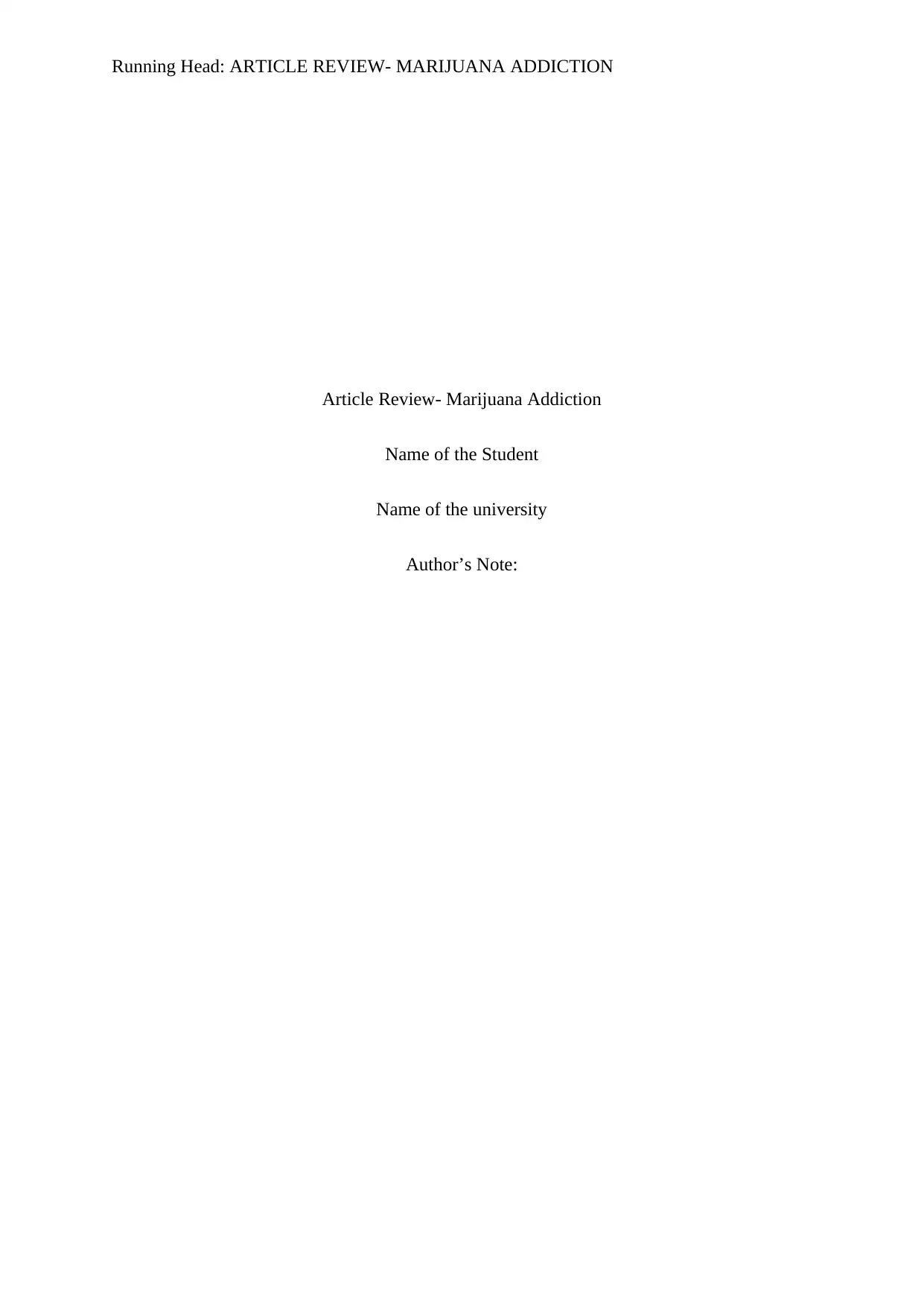
Running Head: ARTICLE REVIEW- MARIJUANA ADDICTION
Article Review- Marijuana Addiction
Name of the Student
Name of the university
Author’s Note:
Article Review- Marijuana Addiction
Name of the Student
Name of the university
Author’s Note:
Paraphrase This Document
Need a fresh take? Get an instant paraphrase of this document with our AI Paraphraser

1ARTICLE REVIEW- MARIJUANA ADDICTION
Table of Contents
Introduction to Article Review...................................................................................................2
References..................................................................................................................................5
Table of Contents
Introduction to Article Review...................................................................................................2
References..................................................................................................................................5
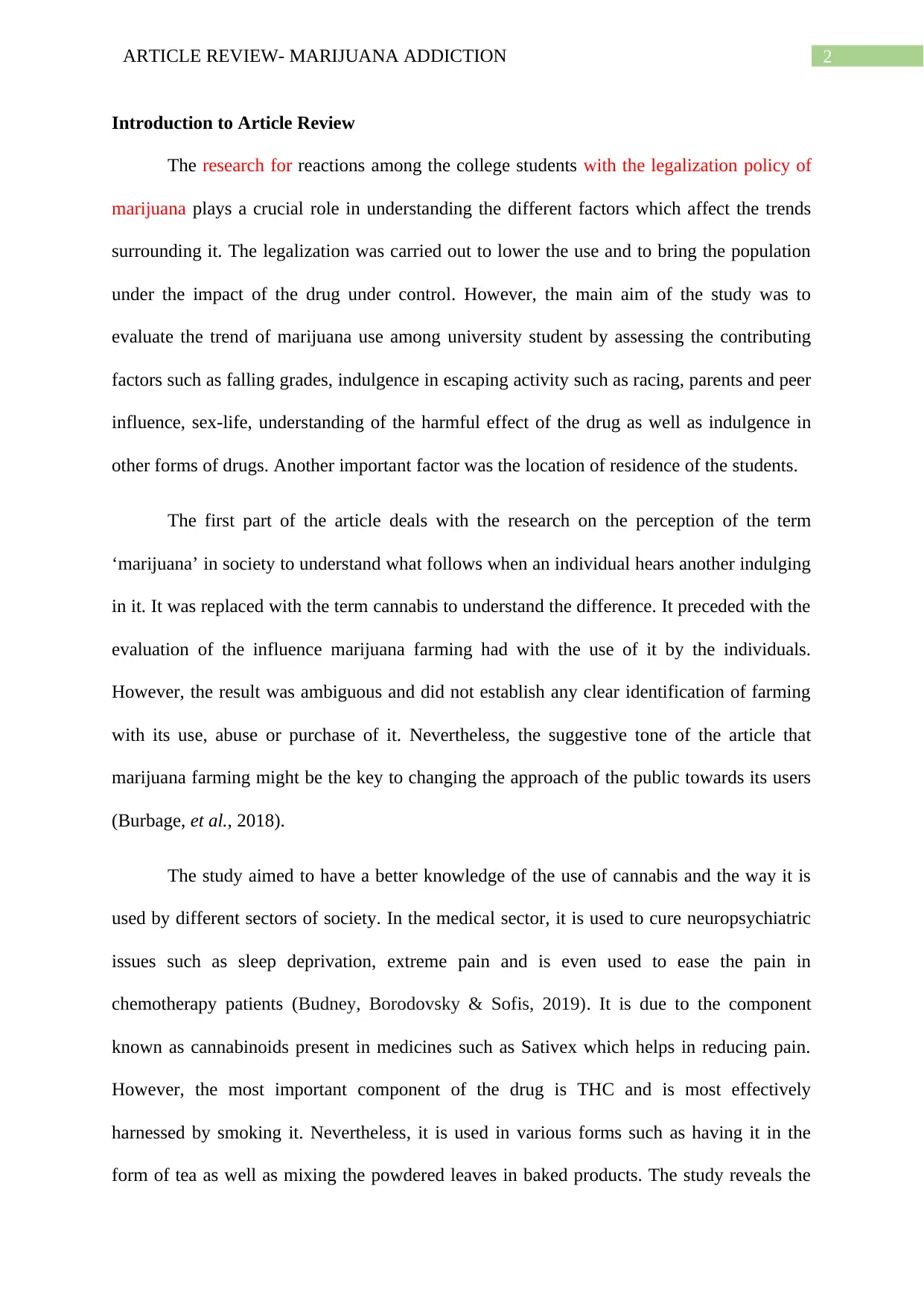
2ARTICLE REVIEW- MARIJUANA ADDICTION
Introduction to Article Review
The research for reactions among the college students with the legalization policy of
marijuana plays a crucial role in understanding the different factors which affect the trends
surrounding it. The legalization was carried out to lower the use and to bring the population
under the impact of the drug under control. However, the main aim of the study was to
evaluate the trend of marijuana use among university student by assessing the contributing
factors such as falling grades, indulgence in escaping activity such as racing, parents and peer
influence, sex-life, understanding of the harmful effect of the drug as well as indulgence in
other forms of drugs. Another important factor was the location of residence of the students.
The first part of the article deals with the research on the perception of the term
‘marijuana’ in society to understand what follows when an individual hears another indulging
in it. It was replaced with the term cannabis to understand the difference. It preceded with the
evaluation of the influence marijuana farming had with the use of it by the individuals.
However, the result was ambiguous and did not establish any clear identification of farming
with its use, abuse or purchase of it. Nevertheless, the suggestive tone of the article that
marijuana farming might be the key to changing the approach of the public towards its users
(Burbage, et al., 2018).
The study aimed to have a better knowledge of the use of cannabis and the way it is
used by different sectors of society. In the medical sector, it is used to cure neuropsychiatric
issues such as sleep deprivation, extreme pain and is even used to ease the pain in
chemotherapy patients (Budney, Borodovsky & Sofis, 2019). It is due to the component
known as cannabinoids present in medicines such as Sativex which helps in reducing pain.
However, the most important component of the drug is THC and is most effectively
harnessed by smoking it. Nevertheless, it is used in various forms such as having it in the
form of tea as well as mixing the powdered leaves in baked products. The study reveals the
Introduction to Article Review
The research for reactions among the college students with the legalization policy of
marijuana plays a crucial role in understanding the different factors which affect the trends
surrounding it. The legalization was carried out to lower the use and to bring the population
under the impact of the drug under control. However, the main aim of the study was to
evaluate the trend of marijuana use among university student by assessing the contributing
factors such as falling grades, indulgence in escaping activity such as racing, parents and peer
influence, sex-life, understanding of the harmful effect of the drug as well as indulgence in
other forms of drugs. Another important factor was the location of residence of the students.
The first part of the article deals with the research on the perception of the term
‘marijuana’ in society to understand what follows when an individual hears another indulging
in it. It was replaced with the term cannabis to understand the difference. It preceded with the
evaluation of the influence marijuana farming had with the use of it by the individuals.
However, the result was ambiguous and did not establish any clear identification of farming
with its use, abuse or purchase of it. Nevertheless, the suggestive tone of the article that
marijuana farming might be the key to changing the approach of the public towards its users
(Burbage, et al., 2018).
The study aimed to have a better knowledge of the use of cannabis and the way it is
used by different sectors of society. In the medical sector, it is used to cure neuropsychiatric
issues such as sleep deprivation, extreme pain and is even used to ease the pain in
chemotherapy patients (Budney, Borodovsky & Sofis, 2019). It is due to the component
known as cannabinoids present in medicines such as Sativex which helps in reducing pain.
However, the most important component of the drug is THC and is most effectively
harnessed by smoking it. Nevertheless, it is used in various forms such as having it in the
form of tea as well as mixing the powdered leaves in baked products. The study reveals the
⊘ This is a preview!⊘
Do you want full access?
Subscribe today to unlock all pages.

Trusted by 1+ million students worldwide
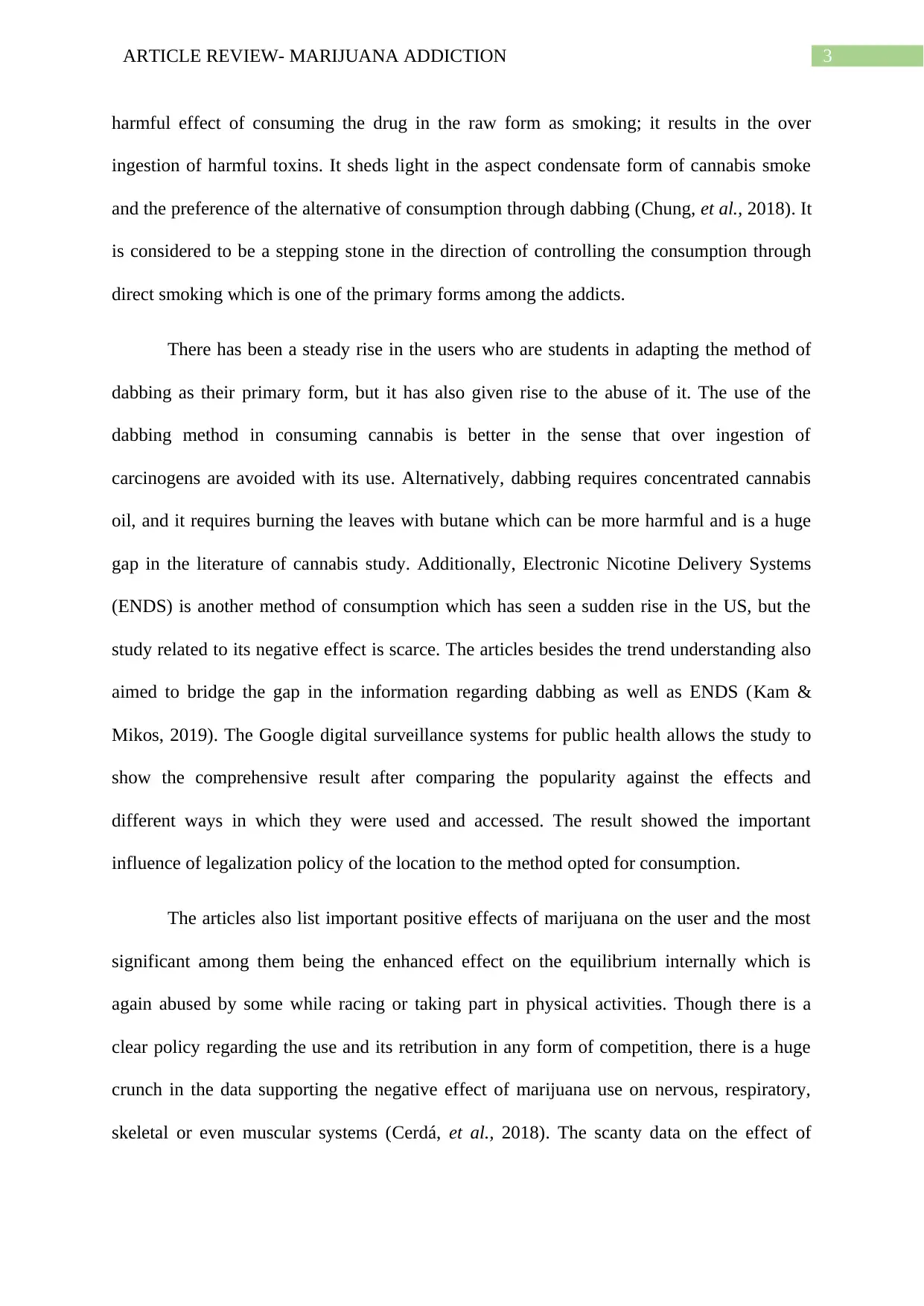
3ARTICLE REVIEW- MARIJUANA ADDICTION
harmful effect of consuming the drug in the raw form as smoking; it results in the over
ingestion of harmful toxins. It sheds light in the aspect condensate form of cannabis smoke
and the preference of the alternative of consumption through dabbing (Chung, et al., 2018). It
is considered to be a stepping stone in the direction of controlling the consumption through
direct smoking which is one of the primary forms among the addicts.
There has been a steady rise in the users who are students in adapting the method of
dabbing as their primary form, but it has also given rise to the abuse of it. The use of the
dabbing method in consuming cannabis is better in the sense that over ingestion of
carcinogens are avoided with its use. Alternatively, dabbing requires concentrated cannabis
oil, and it requires burning the leaves with butane which can be more harmful and is a huge
gap in the literature of cannabis study. Additionally, Electronic Nicotine Delivery Systems
(ENDS) is another method of consumption which has seen a sudden rise in the US, but the
study related to its negative effect is scarce. The articles besides the trend understanding also
aimed to bridge the gap in the information regarding dabbing as well as ENDS (Kam &
Mikos, 2019). The Google digital surveillance systems for public health allows the study to
show the comprehensive result after comparing the popularity against the effects and
different ways in which they were used and accessed. The result showed the important
influence of legalization policy of the location to the method opted for consumption.
The articles also list important positive effects of marijuana on the user and the most
significant among them being the enhanced effect on the equilibrium internally which is
again abused by some while racing or taking part in physical activities. Though there is a
clear policy regarding the use and its retribution in any form of competition, there is a huge
crunch in the data supporting the negative effect of marijuana use on nervous, respiratory,
skeletal or even muscular systems (Cerdá, et al., 2018). The scanty data on the effect of
harmful effect of consuming the drug in the raw form as smoking; it results in the over
ingestion of harmful toxins. It sheds light in the aspect condensate form of cannabis smoke
and the preference of the alternative of consumption through dabbing (Chung, et al., 2018). It
is considered to be a stepping stone in the direction of controlling the consumption through
direct smoking which is one of the primary forms among the addicts.
There has been a steady rise in the users who are students in adapting the method of
dabbing as their primary form, but it has also given rise to the abuse of it. The use of the
dabbing method in consuming cannabis is better in the sense that over ingestion of
carcinogens are avoided with its use. Alternatively, dabbing requires concentrated cannabis
oil, and it requires burning the leaves with butane which can be more harmful and is a huge
gap in the literature of cannabis study. Additionally, Electronic Nicotine Delivery Systems
(ENDS) is another method of consumption which has seen a sudden rise in the US, but the
study related to its negative effect is scarce. The articles besides the trend understanding also
aimed to bridge the gap in the information regarding dabbing as well as ENDS (Kam &
Mikos, 2019). The Google digital surveillance systems for public health allows the study to
show the comprehensive result after comparing the popularity against the effects and
different ways in which they were used and accessed. The result showed the important
influence of legalization policy of the location to the method opted for consumption.
The articles also list important positive effects of marijuana on the user and the most
significant among them being the enhanced effect on the equilibrium internally which is
again abused by some while racing or taking part in physical activities. Though there is a
clear policy regarding the use and its retribution in any form of competition, there is a huge
crunch in the data supporting the negative effect of marijuana use on nervous, respiratory,
skeletal or even muscular systems (Cerdá, et al., 2018). The scanty data on the effect of
Paraphrase This Document
Need a fresh take? Get an instant paraphrase of this document with our AI Paraphraser
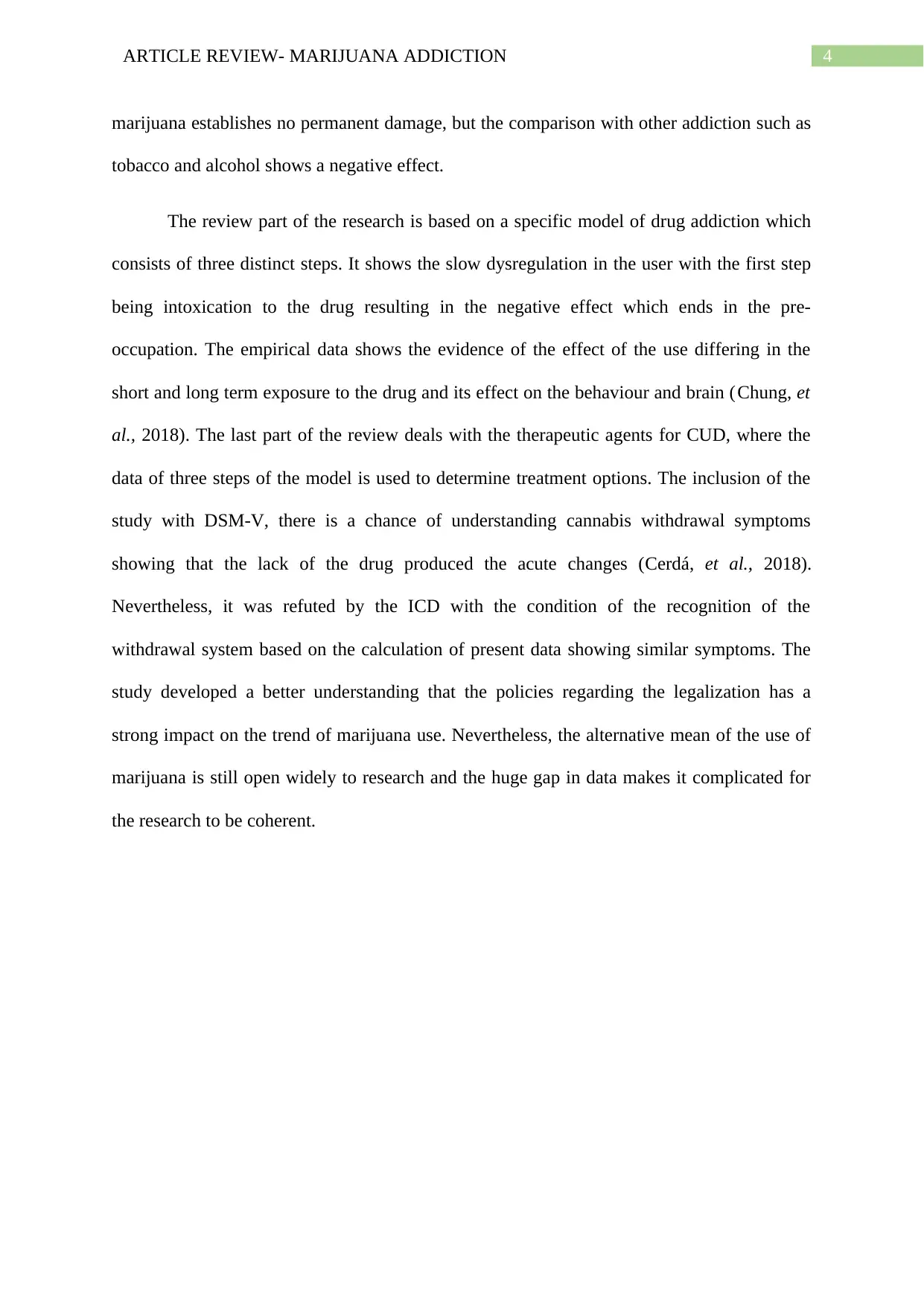
4ARTICLE REVIEW- MARIJUANA ADDICTION
marijuana establishes no permanent damage, but the comparison with other addiction such as
tobacco and alcohol shows a negative effect.
The review part of the research is based on a specific model of drug addiction which
consists of three distinct steps. It shows the slow dysregulation in the user with the first step
being intoxication to the drug resulting in the negative effect which ends in the pre-
occupation. The empirical data shows the evidence of the effect of the use differing in the
short and long term exposure to the drug and its effect on the behaviour and brain (Chung, et
al., 2018). The last part of the review deals with the therapeutic agents for CUD, where the
data of three steps of the model is used to determine treatment options. The inclusion of the
study with DSM-V, there is a chance of understanding cannabis withdrawal symptoms
showing that the lack of the drug produced the acute changes (Cerdá, et al., 2018).
Nevertheless, it was refuted by the ICD with the condition of the recognition of the
withdrawal system based on the calculation of present data showing similar symptoms. The
study developed a better understanding that the policies regarding the legalization has a
strong impact on the trend of marijuana use. Nevertheless, the alternative mean of the use of
marijuana is still open widely to research and the huge gap in data makes it complicated for
the research to be coherent.
marijuana establishes no permanent damage, but the comparison with other addiction such as
tobacco and alcohol shows a negative effect.
The review part of the research is based on a specific model of drug addiction which
consists of three distinct steps. It shows the slow dysregulation in the user with the first step
being intoxication to the drug resulting in the negative effect which ends in the pre-
occupation. The empirical data shows the evidence of the effect of the use differing in the
short and long term exposure to the drug and its effect on the behaviour and brain (Chung, et
al., 2018). The last part of the review deals with the therapeutic agents for CUD, where the
data of three steps of the model is used to determine treatment options. The inclusion of the
study with DSM-V, there is a chance of understanding cannabis withdrawal symptoms
showing that the lack of the drug produced the acute changes (Cerdá, et al., 2018).
Nevertheless, it was refuted by the ICD with the condition of the recognition of the
withdrawal system based on the calculation of present data showing similar symptoms. The
study developed a better understanding that the policies regarding the legalization has a
strong impact on the trend of marijuana use. Nevertheless, the alternative mean of the use of
marijuana is still open widely to research and the huge gap in data makes it complicated for
the research to be coherent.
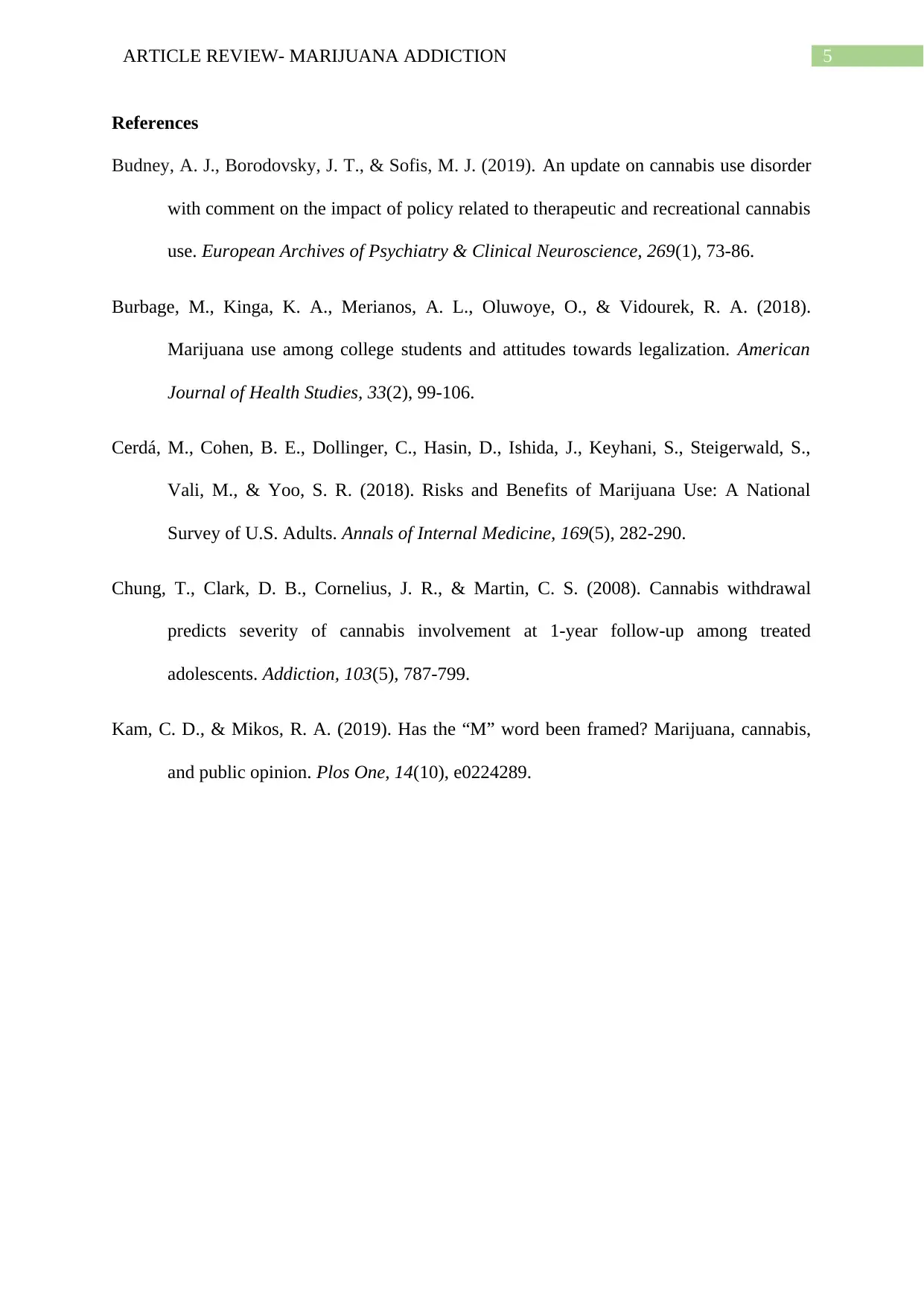
5ARTICLE REVIEW- MARIJUANA ADDICTION
References
Budney, A. J., Borodovsky, J. T., & Sofis, M. J. (2019). An update on cannabis use disorder
with comment on the impact of policy related to therapeutic and recreational cannabis
use. European Archives of Psychiatry & Clinical Neuroscience, 269(1), 73-86.
Burbage, M., Kinga, K. A., Merianos, A. L., Oluwoye, O., & Vidourek, R. A. (2018).
Marijuana use among college students and attitudes towards legalization. American
Journal of Health Studies, 33(2), 99-106.
Cerdá, M., Cohen, B. E., Dollinger, C., Hasin, D., Ishida, J., Keyhani, S., Steigerwald, S.,
Vali, M., & Yoo, S. R. (2018). Risks and Benefits of Marijuana Use: A National
Survey of U.S. Adults. Annals of Internal Medicine, 169(5), 282-290.
Chung, T., Clark, D. B., Cornelius, J. R., & Martin, C. S. (2008). Cannabis withdrawal
predicts severity of cannabis involvement at 1-year follow-up among treated
adolescents. Addiction, 103(5), 787-799.
Kam, C. D., & Mikos, R. A. (2019). Has the “M” word been framed? Marijuana, cannabis,
and public opinion. Plos One, 14(10), e0224289.
References
Budney, A. J., Borodovsky, J. T., & Sofis, M. J. (2019). An update on cannabis use disorder
with comment on the impact of policy related to therapeutic and recreational cannabis
use. European Archives of Psychiatry & Clinical Neuroscience, 269(1), 73-86.
Burbage, M., Kinga, K. A., Merianos, A. L., Oluwoye, O., & Vidourek, R. A. (2018).
Marijuana use among college students and attitudes towards legalization. American
Journal of Health Studies, 33(2), 99-106.
Cerdá, M., Cohen, B. E., Dollinger, C., Hasin, D., Ishida, J., Keyhani, S., Steigerwald, S.,
Vali, M., & Yoo, S. R. (2018). Risks and Benefits of Marijuana Use: A National
Survey of U.S. Adults. Annals of Internal Medicine, 169(5), 282-290.
Chung, T., Clark, D. B., Cornelius, J. R., & Martin, C. S. (2008). Cannabis withdrawal
predicts severity of cannabis involvement at 1-year follow-up among treated
adolescents. Addiction, 103(5), 787-799.
Kam, C. D., & Mikos, R. A. (2019). Has the “M” word been framed? Marijuana, cannabis,
and public opinion. Plos One, 14(10), e0224289.
⊘ This is a preview!⊘
Do you want full access?
Subscribe today to unlock all pages.

Trusted by 1+ million students worldwide
1 out of 6
Related Documents
Your All-in-One AI-Powered Toolkit for Academic Success.
+13062052269
info@desklib.com
Available 24*7 on WhatsApp / Email
![[object Object]](/_next/static/media/star-bottom.7253800d.svg)
Unlock your academic potential
Copyright © 2020–2025 A2Z Services. All Rights Reserved. Developed and managed by ZUCOL.





